Exploring The Architectural Beauty Of Moti Masjid In Agra In 2026
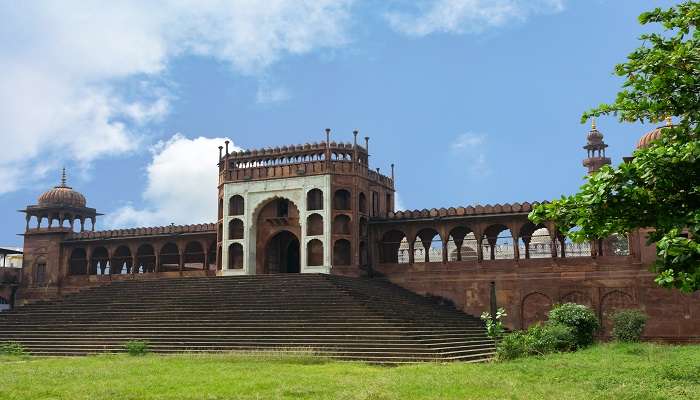
Inside the magnificent complex of Agra Fort lies Moti Masjid, an epitome of timelessness in Mughal architecture and spiritual grace. Called the “Pearl Mosque,” with its brilliant-white marble exterior, this 17th-century wonder spells the greatness and finesse workmanship that characterizes the reign of Emperor Shah Jahan. These imposing domes, ornate carvings, and quiet courtyard of Moti Masjid still serve as one of the most compelling attractions for tourists. Enveloped by the mingling of beauty, history, and spiritual tranquility, this visit to the iconic mosque lets everybody taste an idea about the rich heritage of Agra, its history, and the Mughal architectural empathy.
Moti Masjid location
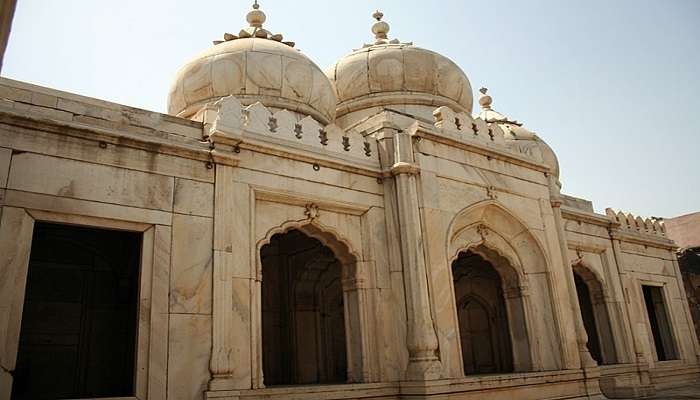
One more Masjid inside the Agra Fort in Agra, Uttar Pradesh, India, is the Moti Masjid or the Pearl Mosque. The Agra Fort, located on the banks of the Yamuna River, features as a UNESCO World Heritage site and is definitely amongst the top historical monuments within the city. Situated at the southernmost end of Agra Fort Complex, the Moti Masjid gives ethereal and historically rich experiences inside architectural magnificence belonging to the Mughal Empire.
Must Read: Aminabad Market In Lucknow
Moti Masjid Architecture

The Masjid, situated within the Agra Fort, is a prime example of the architectural excellence of the Mughal era. Commissioned by Shah Jahan, it is often referred to as the Pearl Mosque due to its radiant appearance, resembling a pearl. Situated north of the Diwan-e-Khaas complex in the Agra Fort, Shah Jahan built the Moti Masjid for the members of his court to offer prayers.
Constructed between 1648 and 1654, the Moti Masjid is a later addition to the Agra Fort, undertaken by Shah Jahan. Several buildings were dismantled during Shah Jahan’s rule, and new structures were erected. Moti Masjid was one of those erections. By completing the mosque’s construction in 1654, the Mughal residence had shifted to Shahjahanpur, the city made by Shah Jahan, for which he was extremely proud.
Design And Layout
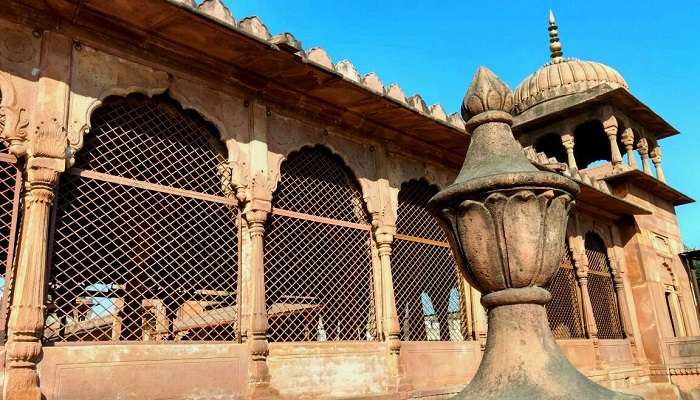
One of the most famous for its symmetrical, balanced, and harmonious design, typically Mughal, is the Moti Masjid. The whole mosque is made of shining white marble. Although it uses a traditional form—three domes and two tall minarets—it has a lot of space around it. The main hall of prayers is ornamented with fine carvings and inlays, displaying the typical Mughal obsession with geometrical and floral patterns. Delicate jalis grace the outer facades, breaking the light to give a serene interior. To avoid groups of people and experience a true sense of calm, you should visit the Moti Masjid in the early morning or late afternoon.
Suggested Read: Shri Kale Ram Temple
Architectural Features
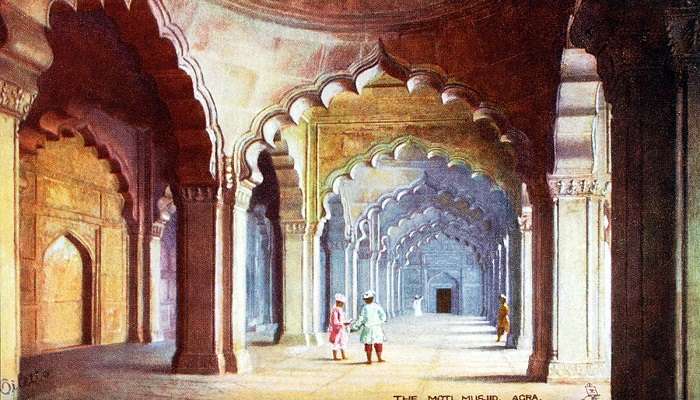
Some of the architectural features of Moti Masjid signify the detailing and grandeur typical of the Mughal style. Special mention needs to be made of the three large onion-shaped domes, crowned in the centre by decorative finials. Structurally, these are set upon sturdy pillars and arched doorways to withstand their own weight while increasing the visual splendour of the mosque. The inner prayer hall is flanked by arched alcoves and mihrabs with marble inscriptions of the Holy Quran that add to the spiritual ambience of this space. Visitors wishing to see the interior of the Moti Masjid should dress appropriately. This is done by covering one’s shoulders, arms, and legs and removing shoes before stepping into the prayer hall in respect of its religious significance.
Historical Significance

Constructed on the orders of Emperor Shah Jahan, it was built in 1654 AD and used as a private mosque by the Mughal rulers within Agra Fort. It got the name “Moti Masjid” or the Pearl Mosque because the exterior is made of pristine white marble, shining brilliant, bright, and lustrous like a pearl under the sun. Apart from its architectural elegance, the Moti Masjid is important as a place for prayers and meditation by the Mughal monarchs; it discloses their religious life and cultural traditions from the peak period of the Mughals’ rule over India. Consider joining a guided tour to Agra Fort, including the Moti Masjid. Guides provide insightful historical context and architectural details that enhance your understanding and appreciation of the mosque’s significance.
Suggested Read: Chhoti Devkali Mandir
Construction And Commissioning
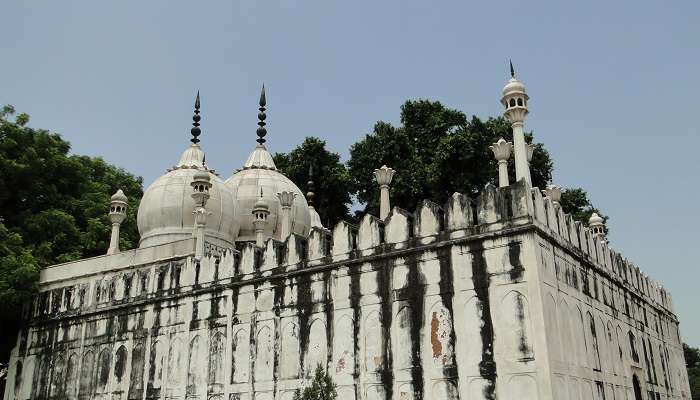
Emperor Shah Jahan made the Taj Mahal and many other neo-monuments, which had great significance in the history of the Mughals. Between 1648 and 1654 AD, Moti Masjid was constructed over Agra Fort, where the Mughal emperors primarily resided in Agra. It was built to cater to the whims of the grand Mughal emperor Shah Jahan, who had ordered its construction primarily as a private mosque for the imperial family. Thereafter, the members of the imperial family had a mosque of their own and a peaceful place to worship at the fort. Built in the typical grand Mughal style of white marble, intricate carvings, and a strongly symmetrical layout that defines Mughal architecture in the aesthetic and religious sensibilities of the period, the mosque is a grand expression of its builders. To enhance your visit to Moti Masjid, get to know the stories and purposes behind it. This will greatly enrich your experience and make complete sense of the architectural details and proper cultural context.
Significance And Legacy
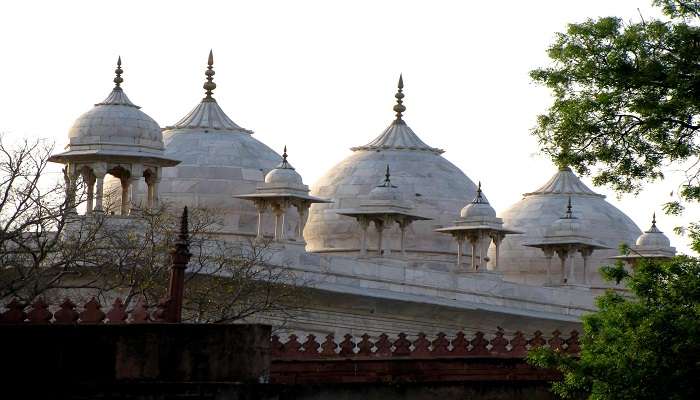
The importance of Moti Masjid could be viewed from its status, whether religiously or by a historical point of view. It was a place for worshipping, representing the area where the Mughal kings could find solace in their prayers and spiritual reflections. From its name, “Moti Masjid,” this added a lot of aesthetic value and importance because of its spotless white marble, shining like a pearl under the sun. Beyond being a place for religious practice, the Moti Masjid is said to be an example of the structural splendour and cultural achievement of the Mughal Empire in its heyday; it was proof of the fact that it bore witness to Shah Jahan’s patronage of the arts and of proof the empire’s guarantee of interfacing Persian, Islamic, and Indian architectural elements that formed the Empire. Today, people from far and wide visit Moti Masjid; it offers an experience of the rich heritage of India and the grandeur of the crafts of that era. Dress appropriately when visiting the Moti Masjid as a sign of respect towards its holiness. This includes covering one’s shoulders, arms, and legs and removing one’s shoes before entering a prayer hall.
Further Read: Barua Sagar
Feel the timeless beauty of Moti Masjid in Agra, which speaks of the serenity of a soul. Ensure that you take a trip to Agra that discovers this marvel of architecture so that you can be mesmerized by it in all its undamaged marble beauty, sprawled exquisitely inside the walls of the Agra Fort. Soak yourself in the architectural and cultural heritage of the Mughal period. Come across the Moti Masjid: devotion and craftsmanship concretized, amazing visitors across continents.
For our editorial codes of conduct and copyright disclaimer, please click here.
Cover Image Source: Shutterstock
Frequently Asked Questions About Moti Masjid
What was the purpose of the Moti Masjid in Agra?
The reason it happens to be of both historical and architectural significance is that it is called the Pearl Mosque. Constructed during Shah Jahan's reign, between 1648 and 1654 AD, the mosque was exclusively for the private use and needs of Mughal rulers residing in the Agra Fort. Its pure white marble structure described by each and every intricate carving, and the symmetrical design portray inside that finest architectural skill of the Mughal era and culture.
Can visitors get inside the Moti Masjid?
Yes, one can get inside the Moti Masjid and view its internal structure, including the main praying hall and the courtyard. One needs to dress modestly, with their shoulders and arms covered, along with their legs, as a gesture of respect for the place and its religious Ishara. Their shoes, too, are taken off before entering the prayer hall, in accordance with the Islamic rituals practiced in mosques.
What is the architecture of Moti Masjid?
This Moti Masjid is famous for its beautiful white marble structure with three large domes, minarets, and jali screens. Beautiful mihrabs, or prayer niches, adorn the interior of the mosque and have verses from the Quran inscribed on them, along with intricate marble carvings. Typical of a Mughal mosque design, it is symmetric and geometric.
How much time does it take to visit the Moti Masjid?
The time required to view the Moti Masjid would depend on individual exploration and one's interest in history and architecture. The average visitor will spend about 30 minutes to an hour at the mosque after the architecture, taking photographs, and reading up on its historical importance.
Is the Moti Masjid a part of the Agra Fort?
Yes, the Moti Masjid is situated in Agra Fort, within the premises of a UNESCO World Heritage site. It lies toward the southern end of the fort complex, adding to its historical and architectural charm alone. Visitors to Agra Fort usually include the Moti Masjid within the itinerary so that they may relish the grandeur of the fort and the calmness of the mosque.
People Also Read:
Toli Masjid Thazhathangady Juma Masjid Jumma Masjid Bijapur

Innovative Content Writer Focused on Producing High quality, Original Content that drives traffic and engages readers. Experienced in Content strategy and analytics to measure content performance using tools such as SQL, Power BI, Excel.











